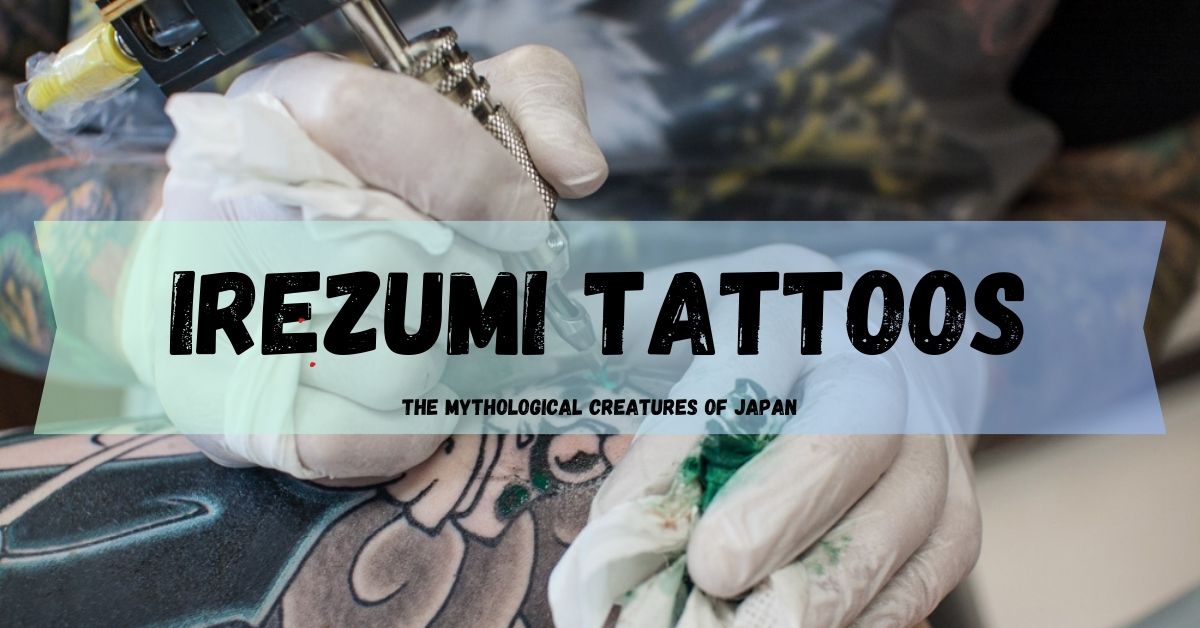Irezumi tattoos, deeply rooted in Japanese culture, carry a rich history and symbolic significance. Embellished with intricate designs and steeped in mythology, these tattoos showcase Japan’s vibrant heritage. Let’s delve into the enthralling realm of Irezumi tattoos and explore the mythological creatures that grace this art form.

Introduction
Irezumi tattoos, an ancient art form originating from Japan, has captured the hearts and imagination of ink enthusiasts worldwide. The origins of Irezumi can be traced back thousands of years, and it has undergone significant transformations over time. This traditional form of tattooing holds a rich history and deep cultural significance. In this article, we delve into the world of Irezumi, exploring its origins, techniques, and the allure that continues to make it a sought-after tattoo style.
Unveiling Japan’s Mythological Wonders Through Irezumi
Irezumi tattoos provide a mesmerizing canvas to explore Japan’s mythological world. Each design tells a unique story, weaving together the tapestry of ancient tales, cultural beliefs, and artistic brilliance. The allure of Irezumi lies not only in its aesthetic appeal but also in its ability to connect with the depths of Japanese heritage.
History of Japanese tattoos
Japanese tattoos, known as “irezumi” (入れ墨) or “horimono” (彫り物), have a rich and intricate history deeply rooted in Japanese culture. They date back thousands of years and have evolved over time, blending traditional techniques and symbolism with modern styles. Here’s an overview of the history of Japanese tattoos:
- Ancient Origins (Approx. 10,000 BCE – 300 CE): Tattooing in Japan has ancient origins, with evidence suggesting its existence as early as the Jomon period (around 10,000 BCE to 300 CE). Tattoos during this period were primarily for spiritual and decorative purposes.
- Yayoi Period (300 BCE – 300 CE): Tattooing continued in the Yayoi period, with a focus on marking individuals based on their social status, achievements, or spiritual beliefs. Tattoos were also used to identify criminals.
- Edo Period (1603 – 1868): The Edo period saw significant development in the art of Japanese tattooing. Tattoos became more elaborate and gained popularity among commoners and the criminal class. Full-body tattoos, known as “irezumi,” emerged, often illustrating traditional Japanese myths, heroes, and folklore.
- Yakuza and Criminal Associations: The Edo period also saw tattoos associated with the yakuza, Japanese organized crime syndicates. Yakuza members often adorned themselves with intricate tattoos, which became a symbol of their identity, status, and loyalty.
- Post-War Era to Present: After World War II, the ban on tattoos was lifted, and the art of Japanese tattooing experienced a revival. Artists like Horiyoshi III and Horihide gained recognition for their exceptional skills and traditional designs.
- Modern Japanese Tattooing: Modern Japanese tattoos continue to draw inspiration from traditional themes, motifs, and techniques. Artists blend traditional styles with contemporary elements, creating a diverse range of designs. Tattoos are admired not only in Japan but also internationally, showcasing the mastery of Japanese tattoo artists.
- Banning and Revival (Late 19th to Early 20th Century)
The Art of Irezumi Tattooing
Irezumi tattoos are more than just body art; they are a symphony of colors, symbols, and stories. Skilled artisans use specialized techniques to create intricate designs. The process involves hand-poking ink into the skin using sharp needles attached to wooden or metal handles, ensuring precision and detail in every stroke.
Brief History and Cultural Significance
Irezumi, which translates to “inserting ink,” dates back centuries and was initially used for spiritual and decorative purposes. It has roots in Japanese culture, where it was a symbol of bravery and a rite of passage. Today, Irezumi embodies traditional Japanese aesthetics, reflecting themes from nature, mythology, and folklore.
And again, Irezumi also known as “horimono” in Japanese, has deep cultural roots in Japan. Historically, Irezumi was associated with the Yakuza, Japan’s organized crime syndicates, who adorned their bodies with intricate designs as a mark of identity and status. Over time, it evolved beyond the criminal underworld and became a celebrated form of art and self-expression.
Evolution of Irezumi in Modern Times
In recent years, Irezumi has gained global recognition, transcending its criminal associations. Modern Irezumi artists draw inspiration from traditional Japanese art, incorporating vibrant colors, intricate designs, and a unique blending of styles. Today, Irezumi is not only a symbol of Japanese heritage but also a globally appreciated art form.
Yakuza tattoos
The Yakuza refer to members of notorious organized crime syndicates in Japan. With origins tracing back to 17th century gamblers and merchant classes, the Yakuza later evolved into powerful outfits engaged in illegal activities like racketeering, extortion and more. They are notorious for the elaborate, ornate tattoo art that covers most of their body minus hands, neck and face to conceal their identity in public.
Yakuza tattoos known as “Irezumi” involve detailed Japanese motifs like dragons, tigers, samurai warriors, geishas and folklore legends. Ink incorporated using the laborious Tebori hand poke method creates beautiful tableau spanning chests, arms and backs. This eye-catching body armour signals their prowess, underworld status and adherence to outlaw traditions. Their tattooed torsos resemble paintings come alive. As elaborate suits would display status in old times, Yakuza etch their skin extensively to showcase their place within the syndicate’s hierarchy. These epidermal ensembles immortalize their life stories and personal beliefs. The ink signals their reverence for cultural history, not social norms. To the outside world, the vibrant motifs elicit diverse reactions from fear to grudging respect for their visual magnificence.
Symbolism and Meanings in Irezumi Tattoos
Common Motifs and Their Significance
Irezumi tattoos often feature various traditional motifs, each laden with its unique symbolism. For instance, the koi fish represents determination and overcoming adversity, while the dragon symbolizes strength and wisdom. So it helps understanding these meanings adds depth and significance to the tattoos.
Koi Fish: Symbol of Resilience and Transformation

The Koi fish, with its vibrant hues and graceful movement, is a prominent motif in Irezumi tattoos. In Japanese folklore, Koi fish are revered for their determination and resilience, symbolizing the ability to overcome obstacles and transform into something greater.
Dragon: The Ultimate Guardian
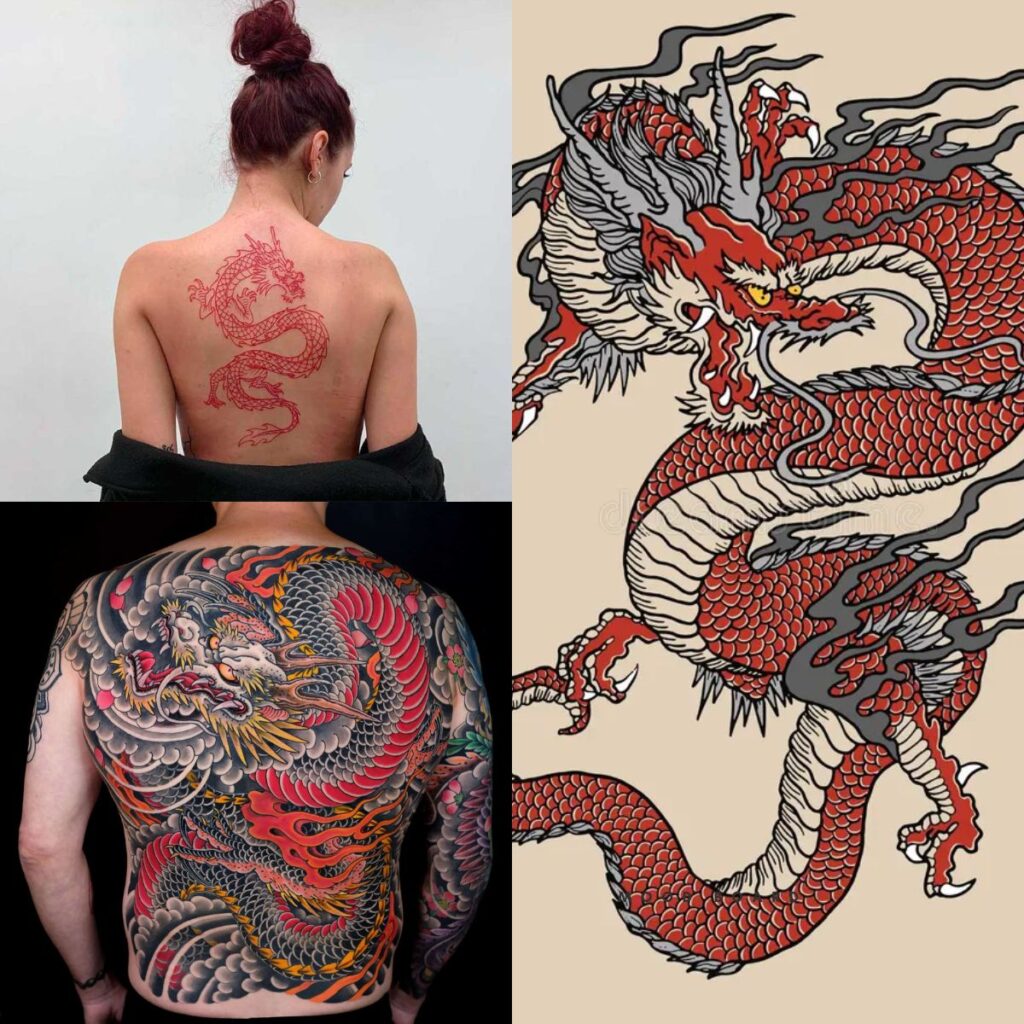
In Japanese mythology, the dragon is a symbol of power, wisdom, and protection. Irezumi often features this mythical creature, believed to bring good fortune and guard against malevolent forces. The dragon’s majestic presence and intricate detailing make it a sought-after design in Irezumi art.
Phoenix: Resurrection and Rebirth

The phoenix, a legendary bird associated with resurrection and rebirth, graces Irezumi tattoos as a representation of transformation and renewal. Its fiery plumage and majestic aura make it a captivating subject, embodying the cyclical nature of life and death.
Kitsune: The Enchanting Fox Spirit
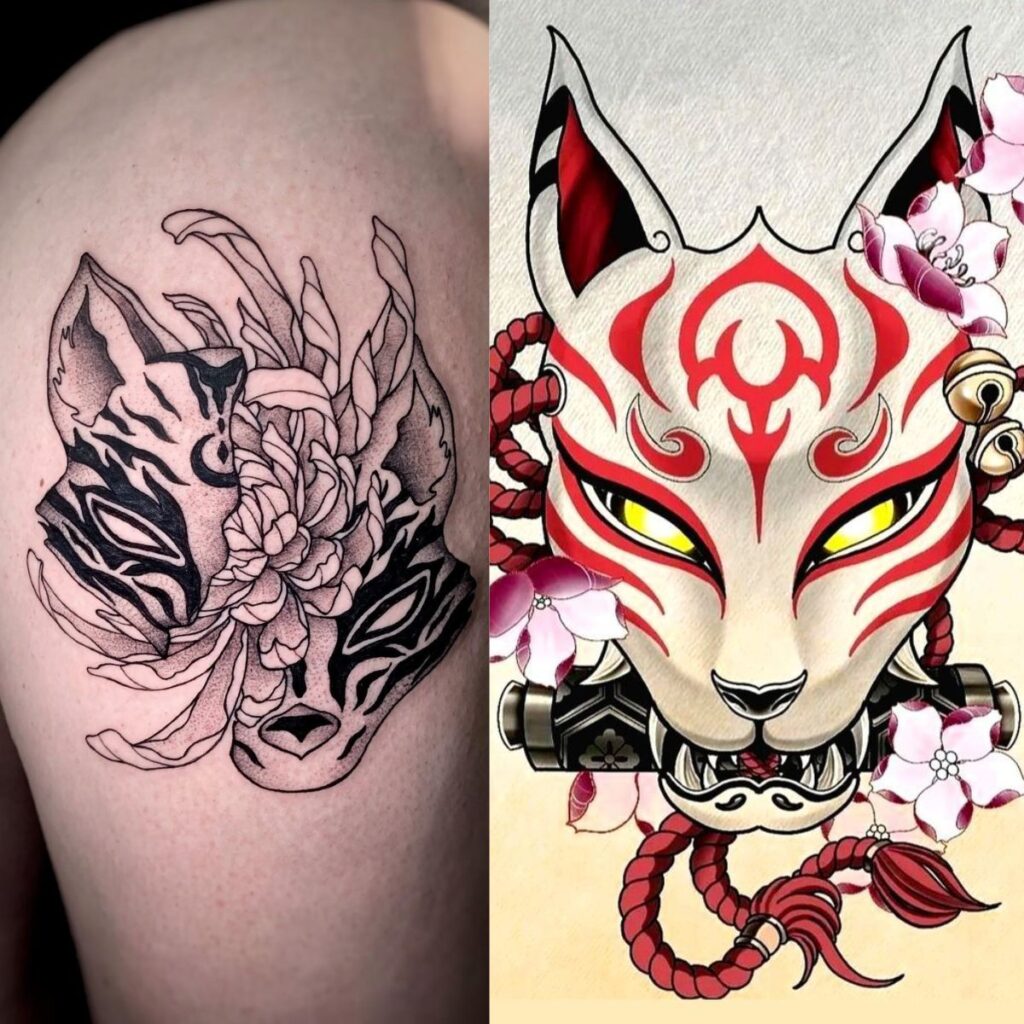
Kitsune, the fox spirit, holds a significant place in Japanese folklore. Often depicted as a beautiful woman or a fox with multiple tails, Kitsune represents intelligence, cunning, and magical abilities. Irezumi featuring Kitsune captures the mystique and allure of this legendary creature.
Cherry Blossom Tattoos (Sakura)
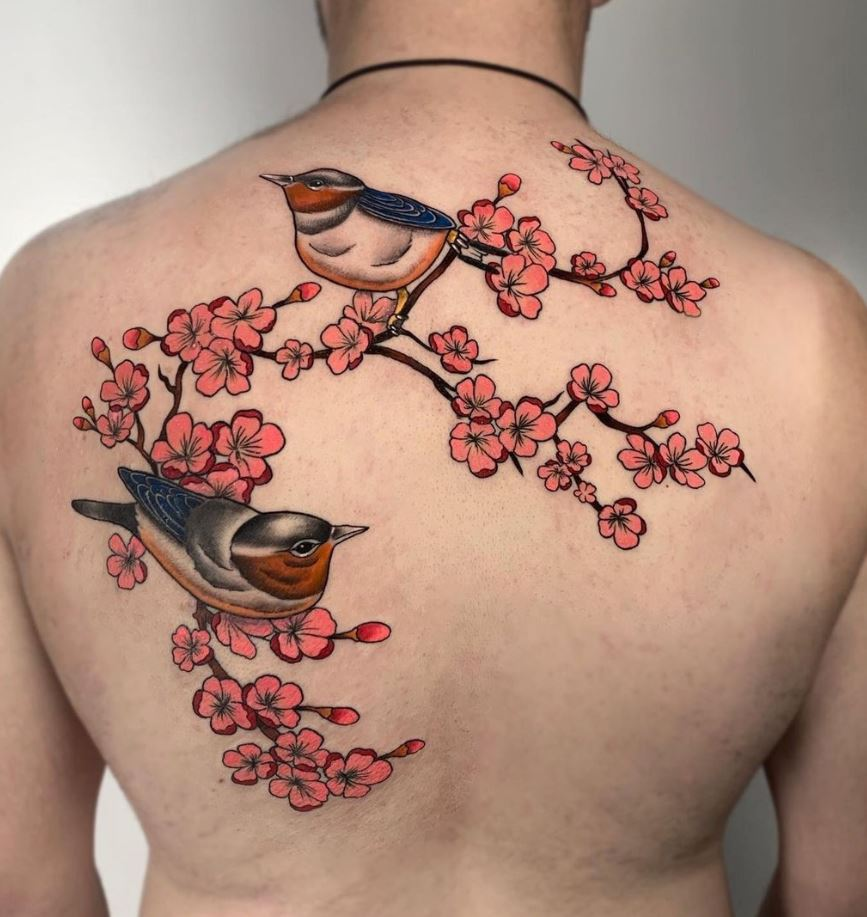
Cherry blossoms symbolize the transience of life and beauty. These delicate, pink flowers are a popular motif in Irezumi, often representing the fleeting nature of existence.
Kirin: The Divine Guardian
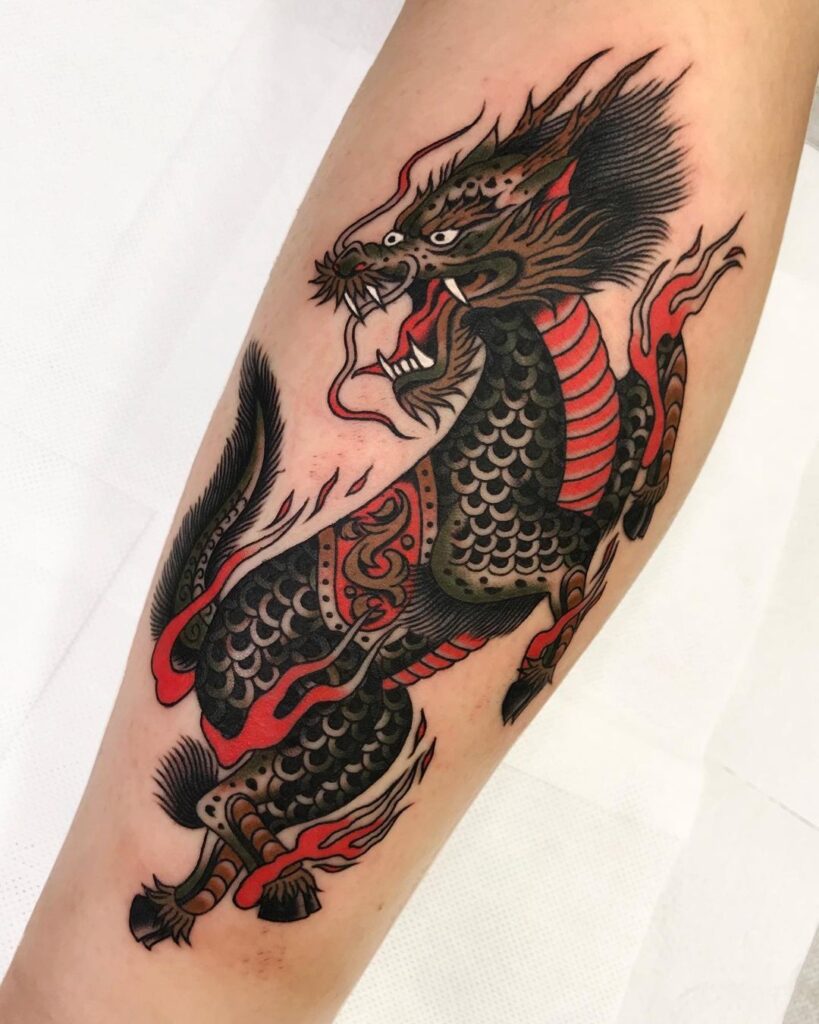
The Kirin, a mythical creature resembling a deer with a dragon’s head, embodies serenity, good omens, and protection. In Irezumi, the Kirin is portrayed with intricate details, showcasing its revered status as a divine guardian and symbol of auspicious beginnings.
Geisha
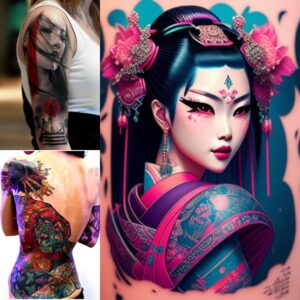
Irezumi tattoos featuring geishas pay homage to these skilled Japanese female entertainers who encapsulate grace and artistry. Geishas are traditional Japanese female entertainers known for their grace and artistry. Geishas exude feminine mystique and represent Japan’s rich cultural legacy through their mastery of traditional dance, music, conversation and more.
An irezumi geisha tattoo depicts her porcelain-doll like visage, floating amidst backdrops like cherry blossoms that celebrate her cultural identity. Meticulous Japanese tattooing brings alive intricate details of her stylized kimono, hair ornaments and subtle expressions as she engages guests. The geisha’s enigmatic world where she seamlessly entertains through elegance and restrained charm is crystallized forever via body art. Irezumi tattoos allow her heritage to bloom through imaginative storytelling. So, Irezumi geisha tattoos celebrate their beauty, elegance, and cultural significance.
Hannya Masks
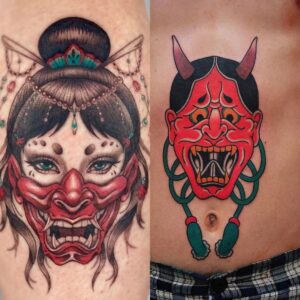
For instance, Hannya masks represent a jealous and vengeful female spirit in Japanese Noh theater. Irezumi hannya mask tattoos embody complex emotions and the duality of human nature.
Peony
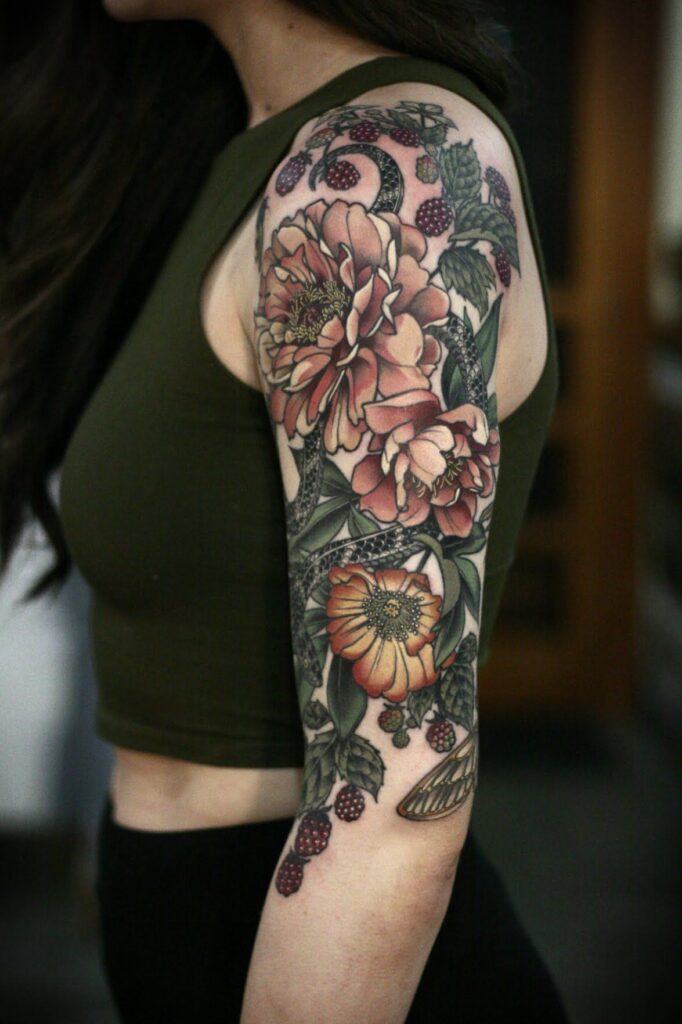
Peonies symbolize prosperity, good fortune, and beauty. They are often associated with wealth, honor, and nobility, representing a flourishing and prosperous life.
Bodhisattva
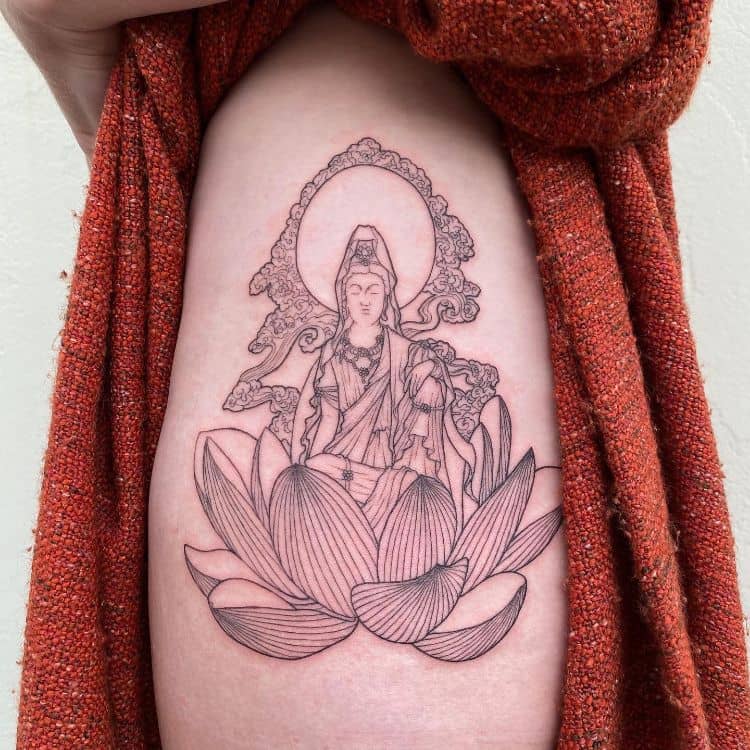
Bodhisattvas are compassionate beings in Buddhism who seek enlightenment not only for themselves but also for others. Irezumi is a form of tattoo art that is deeply connected with Japanese culture and Buddhist beliefs. Irezumi tattoos featuring Bodhisattvas represent compassion, wisdom, and the journey towards spiritual awakening and enlightenment.

Tengu
Tengu are a type of yōkai, which are supernatural creatures or spirits in Japanese folklore. They are primarily linked with themes of chaos and warfare. While modern portrayals usually depict them in a humanoid form, in earlier beliefs, they were envisioned as birds of prey. This is reflected in their distinctive, elongated noses that evolved from their predecessors’ beaks. Tengu are commonly depicted with fierce, wrathful expressions, often painted in red to emphasize their martial symbolism.
Cultural Variations in Symbolism
Symbolism in Irezumi can vary based on cultural contexts. In Japan, specific symbols may hold distinct meanings, conveying cultural stories and beliefs. It’s essential to appreciate these variations to accurately interpret the symbolism in Irezumi tattoos.
Irezumi Tattoo Techniques and Styles
Traditional Irezumi tattoo Techniques
Traditional Irezumi involves using hand tools such as “tebori” (hand-carved needles) to create the tattoo. This technique, which has been passed down through generations, requires exceptional skill and precision. It results in distinct, timeless designs with a characteristic look and feel.
Contemporary Styles and Innovations
Contemporary Irezumi artists often blend traditional techniques with modern tattooing methods, using tattoo machines for efficiency and speed. When this fusion allows for a broader range of styles, from traditional motifs like dragons and koi fish to more modern, personalized designs.
The Irezumi Tattooing Process
Preparation and Design Consultation
Before the tattooing process, a thorough consultation with the artist takes place. This includes discussing design preferences, size, placement, and any customizations. So, Adequate preparation and communication ensure the final tattoo meets your expectations.
Tattooing Process and Aftercare
During the tattooing process, the artist meticulously creates the design, paying attention to every detail. Afterward, following proper aftercare instructions is essential to promote healing and preserve the tattoo’s integrity.
The tattooing process requires significant meticulous artistry to translate a design from paper to skin in a permanent, vivid fashion. A tattoo artist must adeptly control their tools during the tattoo session to deliver clean, elegant lines as per the planned illustration. They have to exhibit steadfast concentration whether creating intricate mandala motifs or photorealistic portraits. Besides the technical skills, understanding client comfort levels through continual communication is also imperative for smooth progress. They carefully wipe excess ink and blood, apply lubricating balms and adjust grip techniques to prevent overworked skin. Even factors like positioning the client’s body ergonomically impact the quality of the artwork.

After this demanding process, adhering to aftercare principles is key to enable the skin to heal while allowing the vivid hues to settle into the dermis. Clients must avoid submerging the tattoo, abstain from picking scabs and gently clean away plasma, ink or soap residue accumulating on the surface. Regular but gentle moisturizing coupled with non-adhesive dressings aids the regeneration process. Avoiding direct sunlight exposure prevents fading. As the epidermis regenerates itself completely within 4-6 weeks, new skin layers will fuse over the embedded ink particles. Strict aftercare ensures the clarity of fine lines and brilliance of exotic colors are locked into the skin, revealing a stunning, enduring work of body art.
Why Irezumi is different from other tattoos?
Irezumi tattoos stand out from other tattoos due to their distinct characteristics deeply rooted in Japanese culture:
- Japanese Aesthetics: Irezumi embodies traditional Japanese aesthetics, featuring unique motifs like dragons, koi fish, and cherry blossoms. The designs often include vibrant colors, intricate detailing, and a sense of harmony.
- Symbolism and Meaning: Each element in an Irezumi tattoo carries specific symbolic meanings deeply ingrained in Japanese culture. Moreover, These tattoos often tell a story or convey personal beliefs, capturing the essence of ancient myths and traditions.
- Techniques and Execution: Traditional Irezumi involves specialized techniques, such as hand-poked methods, showcasing the craftsmanship and skill of the tattoo artist. The use of multiple needles and precise outlining contribute to its distinct appearance.
- Cultural Heritage: Irezumi tattoos have historical significance in Japan, originating from ancient times and evolving over centuries. They were initially associated with criminals and later became an art form embraced by the yakuza, showcasing a unique cultural evolution.
- Long and Detailed Process: Creating an Irezumi tattoo is a time-consuming process, often spanning multiple sessions to ensure meticulous detailing and shading. The dedication and endurance required reflect the commitment to preserving the art form’s integrity.
- Specific Motifs and Themes: Irezumi primarily features traditional Japanese motifs, drawing from folklore, nature, and mythology. So, These motifs are integrated into elaborate and interconnected designs, adding to the distinctiveness of Irezumi.
- Traditional Values and Respect: Irezumi is deeply rooted in respecting tradition and cultural values. So, Artists and enthusiasts often prioritize understanding and preserving the historical and symbolic aspects of this unique tattoo style.
While there’s a rich variety of tattoo styles worldwide, Irezumi tattoos are special due to their encapsulation of Japanese heritage, aesthetics, symbolism, and meticulous execution techniques, making them distinct and highly sought after by tattoo enthusiasts.
Frequently Asked Questions (FAQs)
Are there specific cultural meanings behind Irezumi designs?
Yes, Irezumi designs often have profound meanings deeply rooted in Japanese culture. So, Symbols like dragons represent strength, koi fish embody perseverance, and cherry blossoms signify beauty and impermanence, allowing individuals to choose designs that resonate with them.
What is the difference between tattoo and irezumi?
Basically, The irezumi Japanese tattoo is different from tattoos made in other parts of the world. It is unique owing to its rich colors, deep symbolism and, above all, the traditional tattooing methods, which have been cultivated for centuries.
Is Irezumi tattooing painful?
While pain tolerance varies among individuals, Irezumi tattooing can be uncomfortable due to the hand-poked technique. However, the experienced artists ensure the process is as bearable as possible, and the results are undoubtedly worth the temporary discomfort.
How long does it take to complete an Irezumi tattoo?
Generally, The time required to complete an Irezumi tattoo depends on its size, complexity, and the artist’s skill. Larger and intricate designs may take multiple sessions over weeks or even months to achieve the desired masterpiece.
Can non-Japanese individuals get Irezumi tattoos?
Absolutely! Irezumi tattoos are appreciated globally for their artistic beauty and cultural significance. Artists and enthusiasts alike, regardless of their cultural background, can embrace this ancient art form and find inspiration in its diverse designs.
Conclusion
In conclusion, Irezumi tattoos are a living testament to Japan’s mythical creatures and their enduring significance in the nation’s cultural tapestry. But, As you consider embracing this captivating art form, reflect on the profound meanings and stories behind each design, adding a touch of mystique and heritage to your personal journey.
